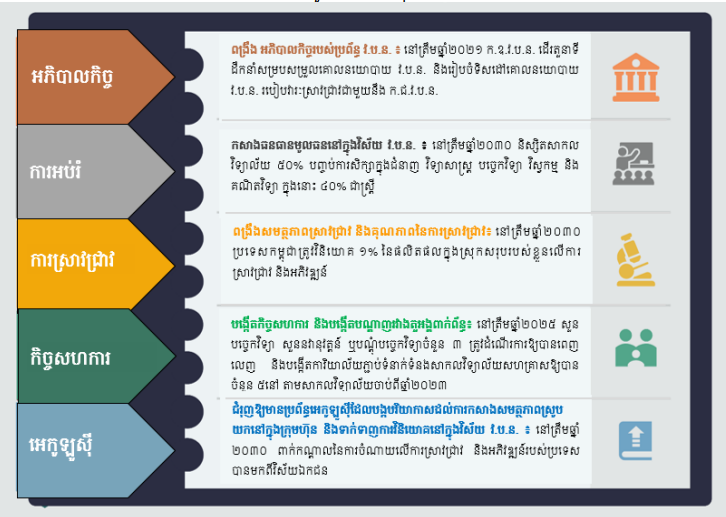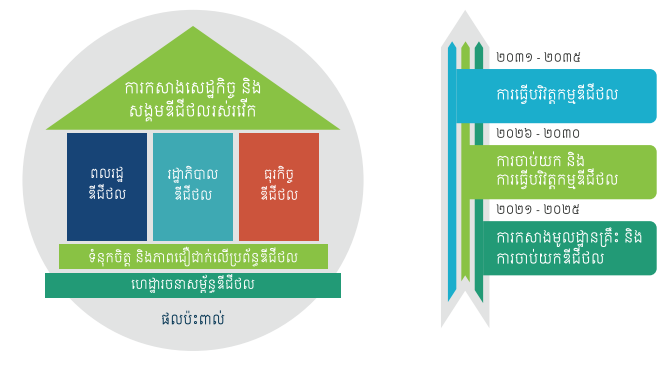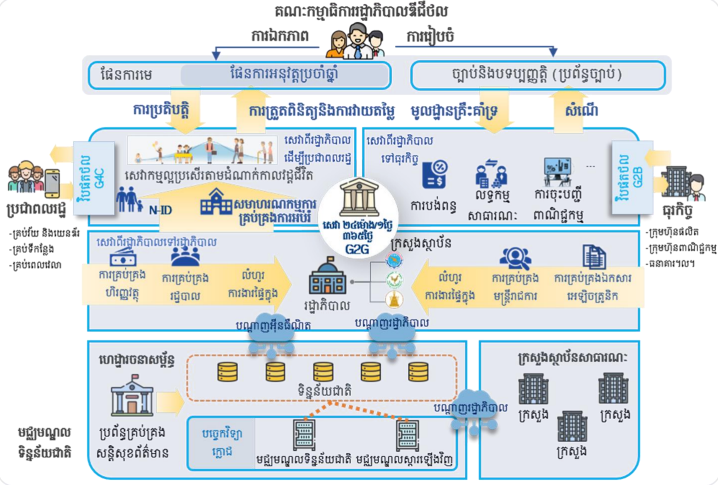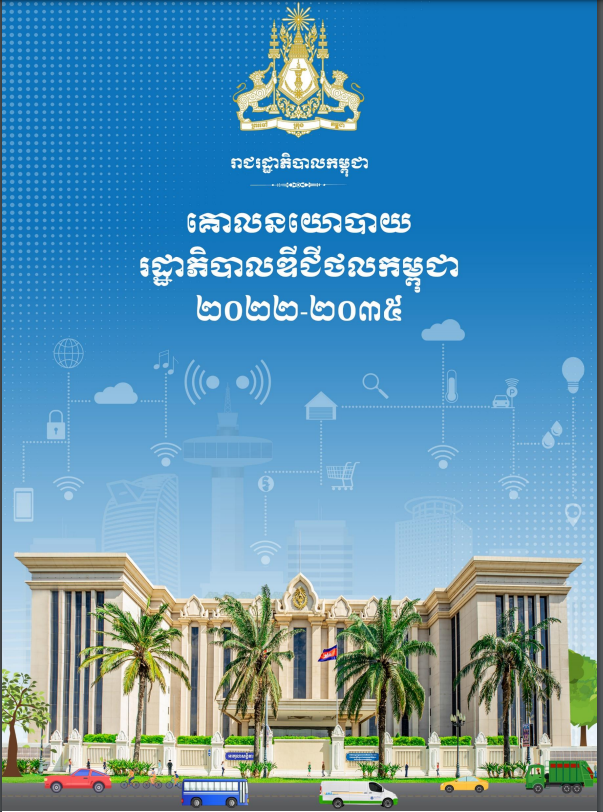ប្រទេសកម្ពុជាមានមហិច្ឆតាក្នុងការផ្លាស់ប្តូរ និងធ្វើឌីជីថលូបនីយកម្មប្រពន្ធ័រដ្ឋាភិបាល និងសេដ្ឋកិច្ចរបស់ខ្លួន។ ការប្តេជ្ញាចិត្តយ៉ាងមុតមាំកើតឡើងបន្ទាប់ពីមានការកំណត់គោលដៅសេដ្ឋកិច្ចដ៏មានមហិច្ឆតារបស់ខ្លួននៅឆ្នាំ ២០៥០ ការត្រៀមខ្លួនដើម្បីបន្តជាមួយនឹងការអភិវឌ្ឍវិទ្យាសាស្ត្រ និងបច្ចេកវិទ្យានៅក្នុងតំបន់ និង និន្នាការពិភពលោក បដិវត្តឧស្សាហកម្មទីបួន (IR 4.0)។1 IR4.0 សំដៅទៅលើនិន្នាការនៃការអភិវឌ្ឍសកលដែលភាពជឿនលឿនផ្នែកបច្ចេកវិទ្យា គឺជាស្នូលនៃការផ្លាស់ប្តូរទេសភាពឧស្សាហកម្មនៃពិភពលោក។2
នៅសតវត្សរ៍ទី ២១ ភាពជឿនលឿននៃវិទ្យាសាស្ត្រ និងបច្ចេកវិទ្យាបានផ្តល់នូវមហិច្ឆតាដ៏មានសក្តានុពលដល់ការអភិវឌ្ឍសេដ្ឋកិច្ចសង្គម ដោយសារតែសមត្ថភាពរបស់វាក្នុងការពន្លឿនផលិតភាព និងការផ្លាស់ប្តូរពិភពលោកឆ្ពោះទៅរកបដិវត្តន៍ឧស្សាហកម្មបន្ទាប់។3 ការរីកដុះដាលនៃនវានុវត្តន៍បច្ចេកវិទ្យាបានធ្វើឱ្យមានការផ្លាស់ប្តូរទីផ្សារការងារពីជំនាញកំរិតទាប និងមធ្យមទៅមូលដ្ឋានជំនាញកំរិតខ្ពស់ដែលបច្ចេកវិទ្យា និងការរីកចម្រើនវិស័យឌីជីថលនាំមកនូវការផ្លាស់ប្តូរនៅក្នុងកត្តាជំរុញសេដ្ឋកិច្ច និងជះឥទ្ធិពលយ៉ាងខ្លាំងដល់ជីវិតប្រចាំថ្ងៃរបស់បុគ្គលម្នាក់ៗ។4
ការផ្លាស់ប្តូរឆ្ពោះទៅរកបដិរត្តឧស្សាហកម្មទី ៤ តម្រូវឱ្យមានមូលដ្ឋានឌីជីថល និងសង្គមដ៏រឹងមាំ និងធន់។ ដោយទទួលស្គាល់យ៉ាងពេញលេញនូវភាពយឺតយ៉ាវរបស់ប្រទេស រាជរដ្ឋាភិបាលកម្ពុជាបានបង្ហាញពីកិច្ចខិតខំប្រឹងប្រែង និងការប្តេជ្ញាចិត្តក្នុងការរួមបញ្ចូលវិទ្យាសាស្ត្រ និងបច្ចេកវិទ្យាទៅក្នុងវិស័យយុទ្ធសាស្ត្រស្នូល រួមមានការអប់រំ សេដ្ឋកិច្ច អភិបាលកិច្ច ប្រតិបត្តិការហិរញ្ញវត្ថុ ការអភិវឌ្ឍហេដ្ឋារចនាសម្ព័ន្ធ និងផលិតកម្ម។
រាជរដ្ឋាភិបាលបានទទួលស្គាល់ពីសារៈសំខាន់នៃវិទ្យាសាស្ត្រ និងបច្ចេកវិទ្យាក្នុងការអភិវឌ្ឍនយោបាយ សង្គម និងសេដ្ឋកិច្ចរបស់ប្រទេស។ ជាលទ្ធផល រាជរដ្ឋាភិបាលបានបង្កើតក្រសួងឧស្សាហកម្ម វិទ្យាសាស្ត្រ បច្ចេកវិទ្យា និងនវានុវត្តន៍ (MISTI)។ ការសម្រេចចិត្តនេះបង្ហាញពីការយកចិត្តទុកដាក់របស់រដ្ឋាភិបាល និងចក្ខុវិស័យរយៈពេលវែងនៃការបង្កើតមូលដ្ឋានគ្រឹះវិទ្យាសាស្ត្រ និងបច្ចេកវិទ្យាដ៏រឹងមាំ។ ក្រសួងឧស្សាហកម្ម វិទ្យាសាស្ត្រ បច្ចេកវិទ្យា និងនវានុវត្តន៍ត្រូវបានបង្កើតឡើងក្នុងឆ្នាំ ២០២០5 ហើយមានទំនួលខុសត្រូវក្នុងការរៀបចំ ការគ្រប់គ្រង ការលើកកម្ពស់ ការគាំទ្រ និងការអនុវត្តគោលនយោបាយ កម្មវិធីអភិវឌ្ឍន៍ និងបច្ចេកវិទ្យាច្នៃប្រឌិតក្នុងវិស័យវិទ្យាសាស្ត្រ បច្ចេកវិទ្យា និងការច្នៃប្រឌិត រួមទាំងសិប្បកម្ម និងទឹកស្អាតនៅថ្នាក់ជាតិ និងថ្នាក់ក្រោមជាតិ។6
គោលនយោបាយវិស័យវិទ្យាសាស្ត្រ និងបច្ចេកវិទ្យា
គោលនយោបាយជាតិ វិទ្យាសាស្ត្រ និងបច្ចេកវិទ្យាសំខាន់ៗ និងក្របខ័ណ្ឌយុទ្ធសាស្ត្ររួមមានៈ
- គោលនយោបាយជាតិស្តីពីវិទ្យាសាស្ត្រ បច្ចេកវិទ្យា និងនវានុវត្តន៍ ២០២០-២០៣០
- ផែនទីបង្ហាញផ្លូវវិទ្យាសាស្ត្របច្ចេកវិទ្យា និងនវានុវត្តន៍ ២០៣០ (ផែនទីបង្ហាញផ្លូវ STI ឆ្នាំ២០៣០ )
- សេដ្ឋកិច្ចឌីជីថល និងក្របខ័ណ្ឌគោលនយោបាយសង្គមរបស់កម្ពុជា ២០២១-២០៣៥
- គោលនយោបាយរដ្ឋាភិបាលឌីជីថល ២០២២-២០៣៥
គោលនយោបាយជាតិស្តីពីវិទ្យាសាស្ត្រ បច្ចេកវិទ្យា និងនវានុវត្តន៍ ២០២០-២០៣០
ស្របតាមគោលដៅសេដ្ឋកិច្ចរបស់កម្ពុជាឆ្នាំ ២០៥០ គោលនយោបាយនេះត្រូវបានបង្កើតឡើងក្នុងឆ្នាំ ២០១៩ និងបង្កើតដោយក្រុមប្រឹក្សាវិទ្យាសាស្ត្រ និងបច្ចេកវិទ្យាជាតិ។ វាត្រូវបានចាត់ទុកថាជាក្របខ័ណ្ឌគោលនយោបាយចម្បង ដែលណែនាំក្រសួង ស្ថាប័នពាក់ព័ន្ធផ្សេងទៀតឱ្យចាត់វិធានការបន្ថែមទៀតចំពោះវិស័យវិទ្យាសាស្ត្រ បច្ចេកវិទ្យា និងនវានុវត្តន៍។ គោលដៅចម្បងនៃគោលនយោបាយនេះ គឺដើម្បីពង្រឹងមូលដ្ឋានគ្រឹះនៃវិទ្យាសាស្ត្រ បច្ចេកវិទ្យា និងនវានុវត្តន៍ និងបង្កើតប្រព័ន្ធអេកូនវានុវត្តន៍សម្រាប់ការអភិវឌ្ឍប្រកបដោយចីរភាព និងធានាការកែលម្អគុណភាពជីវិតនៅគ្រប់ផ្នែក និងវិស័យ។ ក្របខ័ណ្ឌទស្សនាទាននៃគោលនយោបាយនេះសង្កត់ធ្ងន់លើតួនាទីនៃការអភិវឌ្ឍមូលធនមនុស្ស ប្រព័ន្ធអេកូនវានុវត្តន៍ប្រកបដោយភាពច្នៃប្រឌិត និងវិធីសាស្ត្រស្រាវជ្រាវ ដើម្បីកាត់បន្ថយគម្លាតនៃជំនាញវិទ្យាសាស្ត្រ និងបច្ចេកវិទ្យាជាមួយប្រទេសផ្សេងទៀតនៅក្នុងតំបន់។7 ដូចដែលបានរៀបរាប់នៅក្នុងគោលនយោបាយ ការអភិវឌ្ឍវិស័យវិទ្យាសាស្ត្រ បច្ចេកវិទ្យា និងនវានុវត្តន៍មានលក្ខណៈអន្តរវិស័យ និងកំរិតជំនាញខ្ពស់ និងតម្រង់ទិសជំនាញខ្ពស់ ដែលទាមទារឱ្យមានកិច្ចសហប្រតិបត្តិការរវាងក្រសួងពាក់ព័ន្ធ និងភាគីពាក់ព័ន្ធជាច្រើន។ នៅក្នុងផែនការសកម្មភាពនៃគោលនយោបាយនេះ ស្ថាប័នជាតិពាក់ព័ន្ធគួរតែបង្កើតនាយកដ្ឋានវិទ្យាសាស្ត្រ បច្ចេកវិទ្យា និងនវានុវត្តន៍ផ្ទាល់ខ្លួនរបស់ពួកគេ ដើម្បីត្រួតពិនិត្យ ចូលរួម និងកែលម្អវិទ្យាសាស្ត្រ បច្ចេកវិទ្យា និងការស្រាវជ្រាវប្រកបដោយភាពច្នៃប្រឌិត ស្របតាមវិស័យអាទិភាពរបស់ស្ថាប័ននីមួយៗ។ លើសពីនេះ វិទ្យាសាស្ត្រ បច្ចេកវិទ្យា និងនវានុវត្តន៍ក្នុងវិស័យសេវាកម្មសាធារណៈ ដូចជាសកម្មភាពទាក់ទងនឹងកម្មសិទ្ធិបញ្ញា ស្តង់ដារជាតិស្តីពីការបញ្ជាក់ និងសមត្ថភាពបច្ចេកវិទ្យា ត្រូវបានលើកទឹកចិត្តឱ្យកែលម្អ។
ផែនទីបង្ហាញផ្លូវ វិទ្យាសាស្ត្រ បច្ចេកវិទ្យា និងនវានុវត្តន៍កម្ពុជា ២០៣០
ផែនទីបង្ហាញផ្លូវវិទ្យាសាស្ត្រ បច្ចេកវិទ្យា និងនវានុវត្តន៍ ២០៣០ គឺជាក្របខ័ណ្ឌយុទ្ធសាស្ត្រជាតិដែលឆ្លើយតបទៅនឹងតម្រូវការក្នុងការបង្រួបបង្រួមមូលដ្ឋានគ្រឺះនៃ វ.ប.ន ពង្រឹងប្រព័ន្ធអេកូឌីជីថល និងបង្កើតបរិយាកាសសម្រាប់ការអភិវឌ្ឍប្រកបដោយចីរភាព។ ក្រសួងឧស្សាហកម្ម វិទ្យាសាស្ត្រ បច្ចេកវិទ្យា និងនវានុវត្តន៍ (MISTI) បានបង្កើតក្របខ័ណ្ឌគោលនយោបាយ ដោយសង្កត់ធ្ងន់លើវិស័យសំខាន់ៗចំនួនប្រាំ រួមមាន អភិបាលកិច្ច ការអប់រំ ការស្រាវជ្រាវ កិច្ចសហប្រតិបត្តិការ និងប្រព័ន្ធអេកូឡូស៊ី។

សេចក្តីសង្ខេបផែនទីបង្ហាញផ្លូវ វ.ប.ន កម្ពុជា ២០៣០។ ប្រភព: ផែនទីបង្ហាញផ្លូវ វិទ្យាសាស្ត្រ បច្ចេកវិទ្យា និងនវានុវត្តន៍កម្ពុជា ឆ្នាំ ២០៣០។
ផែនទីបង្ហាញផ្លូវចង់សម្រេចគោលបំណងរបស់ខ្លួនដោយការសម្របខ្លួន និងទទួលយកបច្ចេកវិទ្យាដែលមានស្រាប់ និងថ្មី និងគាំទ្រការច្នៃប្រឌិតថ្មី។ សសរស្តម្ភសំខាន់ៗចំនួនប្រាំនៃផែនទីផ្លូវវិទ្យាសាស្ត្រ បច្ចេកវិទ្យា និងនវានុវត្តន៍ឆ្នាំ ២០៣០ គឺ៖
- ពង្រឹងអភិបាលកិច្ចរបស់ប្រព័ន្ធ វ.ប.ន
- កសាងធនធានមូលធនក្នុងវិស័យ វ.ប.ន
- ពង្រឹងសមត្ថភាពស្រាវជ្រាវ និងគុណភាព
- បង្កើនកិច្ចសហការនិងបណ្តាញរវាងតួអង្គពាក់ព័ន្ធ
- ជំរុញប្រព័ន្ធអេកូឡូស៊ីដែលបង្កបរិយាកាសដល់ការពង្រឹងសមត្ថភាពស្រូបយកបច្ចេកវិទ្យា និងចំណេះដឹងថ្មីក្នុងក្រុមហ៊ុន និងទាក់ទាញការវិនិយោគលើវិស័យ វ.ប.ន។
ក្របខ័ណ្ឌគោលនយោបាយសេដ្ឋកិច្ច និងសង្គមឌីជីថលកម្ពុជា ២០២១-២០៣៥
ក្របខ័ណ្ឌគោលនយោបាយនេះមានគោលបំណងកសាងសេដ្ឋកិច្ច និងសង្គមឌីជីថលដ៏រស់រវើកមួយដោយដាក់ជាមូលដ្ឋានគ្រឹះសម្រាប់ការលើកកម្ពស់ការសម្របខ្លួនតាមឌីជីថល និងការផ្លាស់ប្តូរនៅក្នុងគ្រប់វិស័យនៃសង្គមដែលមានដូចជា រដ្ឋាភិបាល ប្រជាពលរដ្ឋ និងអាជីវកម្ម ដើម្បីលើកកម្ពស់កំណើនសេដ្ឋកិច្ចថ្មី និងជំរុញសុខុមាលភាពសង្គមនៅក្នុងគន្លងថ្មីនេះ។ គោលការណ៍សំខាន់ៗចំនួនបីត្រូវបានអនុវត្តនៅក្នុងក្របខ័ណ្ឌគោលនយោបាយនេះ ពោលគឺការកសាងមូលដ្ឋានគ្រឹះឌីជីថល ការអនុម័តឌីជីថល និងការផ្លាស់ប្តូរ។ គោលការណ៍ចំនួនបីត្រូវបានអនុវត្តនៅក្នុងក្របខ័ណ្ឌគោលនយោបាយនេះ ពោលគឺការកសាងមូលដ្ឋានគ្រឹះឌីជីថល ការចាប់យកឌីជីថល និងការធ្វើបរិវត្តកម្មឌីជីថល។8

គោលការណ៍ និងក្របខ័ណ្ឌសម្រាប់កសាងសេដ្ឋកិច្ច និងសង្គមឌីជីថលកម្ពុជា។ ប្រភព: ក្របខណ្ឌគោលនយោបាយសេដ្ឋកិច្ច និងសង្គមឌីជីថលកម្ពុជា ២០២១-២០៣៥។
គោលដៅចម្បងនៃក្របខ័ណ្ឌគោលនយោបាយសេដ្ឋកិច្ចឌីជីថល និងសង្គម ២០២១-២០៣៥ គឺ៖
- ការអភិវឌ្ឍហេដ្ឋារចនាសម្ព័ន្ធ៖ ផ្តោតលើការអភិវឌ្ឍបណ្តាញអ៊ីនធឺណែតល្បឿនលឿន ប្រព័ន្ធទូទាត់ឌីជីថល និងប្រព័ន្ធភ័ស្តុភារសម្រាប់ដំណើរការអភិវឌ្ឍសេដ្ឋកិច្ចសង្គមឌីជីថល។
- ការកសាងភាពជឿជាក់ និងទំនុកចិត្តលើប្រព័ន្ធឌីជីថល៖ សង្កត់ធ្ងន់លើសារៈសំខាន់នៃសន្តិសុខឌីជីថលតាមរយៈការលើកកម្ពស់ការយល់ដឹង និងការបង្កើតប្រព័ន្ធច្បាប់។
- ការកសាងពលរដ្ឋឌីជីថល៖ ការលើកកម្ពស់ភាពជាអ្នកដឹកនាំឌីជីថល ការប្រមូលផ្តុំទេពកោសល្យឌីជីថល និងការផ្លាស់ប្តូរធនធានមនុស្សទៅជាកម្លាំងជំរុញ។
- ការកសាងរដ្ឋាភិបាលឌីជីថល៖ ការលើកកម្ពស់សេវាសាធារណៈឌីជីថល ការកែលម្អអភិបាលកិច្ចផ្អែកលើទិន្នន័យ
- ការបើកធុរកិច្ចឌីជីថល៖ ការលើកទឹកចិត្តដល់សហគ្រាស ជាពិសេសសហគ្រាសធុនតូច និងមធ្យម ដើម្បីទទួលយកបច្ចេកវិទ្យាឌីជីថល និងបង្កើតប្រព័ន្ធអេកូឡូស៊ីចាប់ផ្តើមដំណើរការដ៏រឹងមាំមួយ។
គោលនយោបាយរដ្ឋាភិបាលឌីជីថល ២០២២-២០៣៥
មហិច្ឆិតាក្នុងការបង្កើតរដ្ឋាភិបាលឌីជីថល និងឆ្លាតវៃនៅកម្ពុជាទាមទារឱ្យមានការបង្កើតឡើងនូវប្រព័ន្ធអេកូឡូស៊ីឌីជីថល និងប្រព័ន្ធអេកូនវានុវត្តន៍យ៉ាងរឹងមាំ ដែលអនុញ្ញាតឱ្យមានចន្លោះសម្រាប់បច្ចេកវិទ្យាថ្មីៗ ដើម្បីដំណើរការនៅថ្នាក់ជាតិ និងថ្នាក់ក្រោមជាតិ។ វាពាក់ព័ន្ធនឹងការអភិវឌ្ឍហេដ្ឋារចនាសម្ព័ន្ធឌីជីថល និងធនធានមនុស្ស ដើម្បីយកបច្ចេកវិទ្យាទាន់សម័យទៅប្រើប្រាស់ និងទទួលយកយ៉ាងពេញលេញ។ យុទ្ធសាស្ត្រទី ៥ ផ្តោតលើការរៀបចំអភិបាលកិច្ចរដ្ឋាភិបាលឌីជីថល ដែលក្នុងយុទ្ធសាស្ត្រនេះមានរៀបរាប់ពីការអនុវត្តច្បាប់ស្តីពីរដ្ឋាភិបាលឌីជីថល។ តាមរយៈសិក្ខាសាលាផ្សព្វផ្សាយគោលនយោបាយរដ្ឋាភិបាលឌីជីថល សេចក្តីព្រាងច្បាប់ស្តីពីរដ្ឋាភិបាលឌីជីថលត្រូវបានបង្ហាញដោយអនុរដ្ឋលេខាធិការក្រសួងប្រៃសណីយ៍ និងទូរគមនាគមន៍ ហើយបច្ចុប្បន្នសេចក្តីព្រាងនេះកំពុងស្ថិតក្នុងដំណើរការអភិវឌ្ឍ។9 សេចក្តីព្រាងច្បាប់នេះចែកចេញជា ២០ ជំពូក ដែលមានបំណងគ្រប់គ្រងគ្រប់សកម្មភាពដែលពាក់ព័ន្ធរដ្ឋាភិបាល និងអភិបាលកិច្ចឌីជីថល។10

រូបភាពរួមនៃការរៀបចំគោលនយោបាយរដ្ឋាភិបាលឌីជីថលកម្ពុជា ២០២២-២០៣៥។ ប្រភព: គោលនយោបាយរដ្ឋាភិបាលឌីជីថលកម្ពុជា ២០២២-២០៣៥។
ប្រទេសកម្ពុជាបានស្រមើឃើញរដ្ឋាភិបាលឆ្លាតវៃ និងប្រព័ន្ធផ្តល់សេវាសាធារណៈប្រកបដោយគណនេយ្យភាពផ្អែកលើហេដ្ឋារចនាសម្ព័ន្ធឌីជីថល។ គោលនយោបាយជាតិនេះនឹងធ្វើទំនើបកម្មប្រព័ន្ធអភិបាលកិច្ច ដោយដាក់ចេញនូវយុទ្ធសាស្ត្រសំខាន់ៗចំនួន ១០ ដូចជា៖
- ការរៀបចំ និងកែលម្អហេដ្ឋារចនាសម្ព័ន្ធការតភ្ជាប់ឌីជីថល
- ការរៀបចំ និងកែលម្អហេដ្ឋារចនាសម្ព័ន្ធប្រព័ន្ធទូទាត់សងប្រាក់ឌីជីថលសម្រាប់សេវាសាធារណៈ
- ការរៀបចំ និងពង្រឹងហេដ្ឋារចនាសម្ព័ន្ធសន្តិសុខឌីជីថល
- ការអភិវឌ្ឍហេដ្ឋារចនាសម្ព័ន្ធសេវាប្រៃសណីយ៍
- ការរៀបចំអភិបាលកិច្ចរដ្ឋាភិបាលឌីជីថល
- ការធ្វើបដិវត្តកម្មរដ្ឋាភិបាលឌីជីថល និងសេវាសាធារណៈ
- ការកសាងមូលធនមនុស្សឌីជីថល
- លើកកម្ពស់ការស្រាវជ្រាវ និងនវានុវត្តន៍ឌីជីថល
- រៀបចំកិច្ចសហប្រតិបត្តិការជាមួយក្រុមហ៊ុនបច្ចេកវិទ្យាឌីជីថល
- លើកកម្ពស់ធុរកិច្ចថ្មីឌីជីថល។
បញ្ហាប្រឈម និងដំណើរឆ្ពោះទៅមុខ
ដើម្បីផ្លាស់ប្តូរ និងធធ្វើឌីជីថលូបនីយកម្មរដ្ឋាភិបាល សង្គម និងសេដ្ឋកិច្ច រាជរដ្ឋាភិបាលកម្ពុជាត្រូវតែជម្នះបញ្ហាប្រឈម និងការគម្រាមកំហែងផ្សេងៗដែលទាក់ទងនឹងការប្រើប្រាស់វិទ្យាសាស្ត្រ និងបច្ចេកវិទ្យាដែលមានដូចជារួមការផ្លាស់ប្តូរឌីជីថលប្រកបដោយបរិយាបន្ន ការវាយប្រហារតាមប្រព័ន្ធអ៊ីនធឺណិត ឧក្រិដ្ឋកម្មតាមប្រព័ន្ធអ៊ីនធឺណិត និងការការពារឯកជនភាព។
សន្តិសុខសាយប័រ និងការការពារឯកជនភាព
រដ្ឋាភិបាលជុំវិញពិភពលោកបានទទួលស្គាល់កាន់តែខ្លាំងឡើងអំពីសារៈសំខាន់នៃសន្តិសុខសាយប័រក្នុងការដោះស្រាយជាមួយនឹងការបញ្ហាប្រឈមដែលបណ្តាលមកពីការប្រើប្រាស់បច្ចេកវិទ្យាឌីជីថលទំនើប។11 យោងតាមអភិបាលកិច្ចពត៌មានវិទ្យាររបស់ចក្រភពអង់គ្លេស សន្តិសុខតាមអ៊ីនធឺណិត គឺ “ជាកម្មវិធីនៃបច្ចេកវិទ្យា ដំណើរការ និងការគ្រប់គ្រង ដើម្បីការពារប្រព័ន្ធ បណ្តាញ កម្មវិធី ឧបករណ៍ និងទិន្នន័យពីការវាយប្រហារតាមអ៊ីនធឺណិត។”12 ហានិភ័យតាមអ៊ីនធឺណិតដូចជាការវាយប្រហារតាមប្រព័ន្ធអ៊ីនធឺណិត ឧក្រិដ្ឋកម្មតាមប្រព័ន្ធអ៊ីនធឺណិត ការបោកប្រាស់តាមប្រព័ន្ធអ៊ីនធឺណិត ការក្លែងបន្លំ និងបញ្ហាការពារទិន្នន័យបាននឹងកំពុងកើនឡើងយ៉ាងឆាប់រហ័សក្នុងរយៈពេលប៉ុន្មានទសវត្សរ៍ចុងក្រោយនេះ ដោយសារតែការកើនឡើងនៃការសម្របខ្លួននៃបច្ចេកវិទ្យាឌីជីថល និងបច្ចេកវិទ្យាថ្មី។
រដ្ឋាភិបាលកម្ពុជាធ្លាប់បានជួបប្រទះការវាយប្រហារតាមអ៊ីនធឺណិតមួយចំនួននៅលើគេហទំព័រផ្លូវការ ហើយពួក Hacker បានលេចធ្លាយព័ត៌មានសម្ងាត់ទាំងនោះនៅលើប្រព័ន្ធអ៊ីនធឺណិត។13 ជារឿយៗ ប្រជាពលរដ្ឋ និងអាជីវករបានរាយការណ៍អំពីការឆបោក និងការក្លែងបន្លំតាមអ៊ីនធឺណិតទៅអាជ្ញាធរ ដែលធ្វើឲ្យពួកគេខាតបង់ពេលវេលា និងថវិកា។ ជាងនេះទៅទៀត ពួក Hacker ក៏បានដាក់គោលដៅវាយប្រហារលើក្រុមហ៊ុនផ្តល់សេវាអ៊ីនធឺណិត (ISP) ដ៏ធំបំផុតមួយចំនួនរបស់កម្ពុជា ក្នុងទម្រង់ distributed denial-of-service (DDoS)14 វាបណ្តាលឱ្យមានបញ្ហាការតភ្ជាប់អ៊ីធឺណិតនៅទូទាំងប្រទេស។ ទាំងនេះគឺជាឧទាហរណ៍មួយចំនួននៃផលវិបាកដែលរំខាននៃការវាយប្រហារតាមអ៊ីនធឺណិត និងរបៀបដែលពួកគេអាចប៉ះពាល់ដល់ជីវិតប្រចាំថ្ងៃរបស់ប្រជាពលរដ្ឋ។
រដ្ឋាភិបាលកម្ពុជាបានពង្រឹងក្របខ័ណ្ឌអភិបាលកិច្ចអ៊ីនធឺណិតរបស់ខ្លួនដោយបង្កើតច្បាប់ផ្សេងៗដែលទាក់ទងនឹង បទបញ្ជា និងអាជ្ញាធរសន្តិសុខសាយប័រ។ ការិយាល័យឆ្លើយតបបញ្ហាបន្ទាន់នៃកុំព្យូទ័រ (CamCERT) ត្រូវបានបង្កើតឡើងក្នុងឆ្នាំ ២០០៧។15 CamCERT មានទំនួលខុសត្រូវក្នុងការផ្តល់ព័ត៌មានស្តីពីយោបល និងគន្លឺះដំបូន្មានសុវត្ថិភាពកុំព្យូទ័រដល់ភាគីពាក់ព័ន្ធទាំងអស់ដែលមានហានិភ័យខ្ពស់នៃការវាយប្រហារតាមអ៊ីនធឺណិត។ វាក៏ដើរតួជនបង្គោលនៅកម្ពុជាសម្រាប់ឆ្លើយតប និងដោះស្រាយបញ្ហាសុវត្ថិភាពកុំព្យូទ័រ។16 ក្រុមការងារបានបង្កើតប្រព័ន្ធជូនដំណឹងជាមុនស្តីអំពីសន្តិសុខព័ត៌មាន ស្រាវជ្រាវបច្ចេកវិទ្យាថ្មីៗ និងគ្រប់គ្រងមជ្ឈមណ្ឌលសន្តិសុខជាតិ។17
ទីស្តីការគណៈរដ្ឋមន្ត្រី បានបង្កើតក្រុមការងារមួយនៅឆ្នាំ ២០១០ ដើម្បីធ្វើការតាក់តែងច្បាប់ស្តីពីឧក្រិដ្ឋកម្មតាមប្រព័ន្ធបច្ចេកវិទ្យាគមនាមន៍ និងព័ត៌មានដែលជាឯកសារច្បាប់ចម្បងរបស់ប្រទេសកម្ពុជា ដែលដោះស្រាយបញ្ហាទាក់ទងនឹងប្រព័ន្ធអ៊ីនធឺណិត។ ទោះជាយ៉ាងណាក៏ដោយ ច្បាប់នេះស្ថិតក្នុងដំណើរការនៃការធ្វើសេចក្តីព្រាង។ ខ្លឹមសារដ៏ចម្រូងចម្រាសរបស់ច្បាប់នេះបានធ្វើឱ្យមានប្រតិកម្មជាសាធារណៈ និងការភ័យខ្លាចថា ច្បាប់នេះអាចនឹងរឹតត្បិតថែមទៀតទៅលើសិទ្ធិមនុស្ស និងសេរីភាពនៃការបញ្ចេញមតិតាមអ៊ីនធឺណិតនៅក្នុងប្រទេស។18 ក្នុងឆ្នាំ ២០១៥ ក្រសួងប្រៃសណីយ៍ និងទូរគមនាគមន៍បានចេញសេចក្តីបំភ្លឺមួយ ដើម្បីឆ្លើយតបទៅនឹងក្តីបារម្ភទាំងនោះថា សេចក្តីព្រាងច្បាប់នេះកំពុងស្ថិតក្នុងដំណាក់កាលដំបូងនៃការអភិវឌ្ឍ ហើយច្បាប់នេះមានគោលបំណងទប់ស្កាត់ និងប្រយុទ្ធប្រឆាំងនឹងឧក្រិដ្ឋកម្មតាមប្រព័ន្ធអ៊ីនធឺណិតដោយប្រើការអនុវត្តច្បាប់។19
ក្រោមក្រសួងសេដ្ឋកិច្ច និងហិរញ្ញវត្ថុ ថ្នាលផ្លាស់ប្តូរទិន្នន័យកម្ពុជា (CamDX) ត្រូវបានបង្កើតឡើង ដើម្បីដោះស្រាយជាមួយនឹងការការពារទិន្នន័យ និងការការពារឯកជនភាពនៅក្នុងសង្គមដែលផ្តោតលើឌីជីថល។ វាគឺជាវេទិកាប្រកបដោយភាពច្នៃប្រឌិតដែលមានគោលបំណងពង្រីកអាជីវកម្មថ្មីនៅក្នុងប្រទេស។20 CamDX ផ្តល់វេទិកាផ្លាស់ប្តូរទិន្នន័យដែលអាចទុកចិត្តបាន និងមានសុវត្ថិភាព។ យោងតាមគេហទំព័រផ្លូវការរបស់គេ CamDX ធានាថាការផ្លាស់ប្តូរទិន្នន័យរវាងប្រព័ន្ធព័ត៌មាន និងសេវាកម្មអតិថិជនអាចទុកចិត្តបាន និងមានសុវត្ថិភាពដោយប្រើបច្ចេកវិទ្យាស្តង់ដារ និងម៉ាស៊ីនមេដែលមានសុវត្ថិភាព។ វាធ្វើឱ្យប្រាកដថាការផ្លាស់ប្តូរទិន្នន័យរវាងអតិថិជនត្រូវបានឆ្លងកាត់កូនីយកម្ម (encryption) ដែលផ្តល់នូវឯកជនភាព និងរក្សាការសម្ងាត់។ គិតត្រឹមខែធ្នូ ឆ្នាំ ២០២១ មានប្រតិបត្តិការប្រចាំថ្ងៃជាមធ្យមចំនួន ១២,៩៦៤ និងអាជីវកម្ម/សហគ្រាសប្រមាណ ១០, ១៤៧ ដែលបានចុះបញ្ជីនៅលើវេទិកាចុះបញ្ជីអាជីវកម្មរបស់ CamDX ។21
ការផ្លាស់ប្តូរឌីជីថលប្រកបដោយបរិយាបន្ន
ក្នុងអំឡុងពេលនៃការផ្លាស់ប្តូរឌីជីថល បញ្ហាទាក់ទងជាមួយនឹងលទ្ធភាពប្រើប្រាស់ឌីជីថលមិនស្មើគ្នា និងគម្លាតបច្ចេកវិទ្យាអាចបង្កបញ្ហាប្រឈមសម្រាប់រដ្ឋាភិបាល និងសង្គមរបស់កម្ពុជា។ អង្គការសហប្រជាជាតិបានបង្កើតក្របខ័ណ្ឌនៃ “វិធីសាស្ត្រនៃសង្គមទាំងមូល” សម្រាប់ការផ្លាស់ប្តូរឌីជីថលប្រកបដោយបរិយាបន្នដោយផ្អែកលើគោលការណ៍សំខាន់ៗចំនួនបួន៖ សកលភាព ការទទួលខុសត្រូវ សមភាព និងបើកចំហ។22 រដ្ឋាភិបាល និងអ្នកបង្កើតគោលនយោបាយគួរតែទទួលយកគំនិតនៃវិធីសាស្ត្រនេះនៅពេលបង្កើតគោលនយោបាយ។23 វិធីសាស្ត្រនេះគឺផ្អែកលើសញ្ញាណនៃការរួមបញ្ចូលឌីជីថលដែលមិនចោលនរណាម្នាក់ និងធានាឱ្យមានការចូលប្រើប្រាស់ឌីជីថលស្មើគ្នាក្នុងអំឡុងពេលនៃការផ្លាស់ប្តូរ។
យោងតាមអ្នកជំនាញរបស់កម្មវិធីអភិវឌ្ឍន៍អង្គការសហប្រជាជាតិកំណែទម្រង់ឌីជីថល កម្ពុជាចាំបាច់ត្រូវដោះស្រាយឧបសគ្គនៃគម្លាតឌីជីថលជាមុនសិន ដើម្បីសម្រេចបាននូវការបំប្លែងឌីជីថលប្រកបដោយបរិយាបន្ន និងដោយរលូន។24 ឧទាហរណ៍នៃរបាំងគម្លាតឌីជីថលមានដូចជាការចូលប្រើ ការតភ្ជាប់អ៊ីនធឺណិត និងគម្លាតធំទូលាយនៃចំណេះដឹងឌីជីថល។25 នៅឆ្នាំ ២០២១ មានប្រជាជនចំនួន ៨, ៨៦ លាននាក់បានប្រើប្រាស់អ៊ីនធឺណិត ដែលស្មើនឹង ៥០% នៃចំនួនប្រជាជនសរុប។26 សហភាពទូរគមនាគមន៍អន្តរជាតិ (ITU) បានរកឃើញនៅឆ្នាំ ២០១៧ ថាមានតែ ៣០% នៃគ្រួសារនៅតំបន់ជនបទ និង៥០% នៃប្រជាជននៅទីក្រុងប៉ុន្នោះដែលមានអ៊ីនធឺណិតប្រើប្រាស់។27 ឯកឧត្តម ជា វ៉ាន់ដេត រដ្ឋមន្ត្រីក្រសួងប្រៃសណីយ៍ និងទូរគមនាគមន៍ មានប្រសាសន៍ថាជាងនេះទៅទៀត មានតែ ៣០% នៃប្រជាជនទាំងអស់ប៉ុណ្ណោះដែលទទួលបានចំណេះដឹងផ្នែកឌីជីថលជាមូលដ្ឋានដែលអាចប្រើប្រាស់ឧបករណ៍ និងវេទិកាឌីជីថលបាន។28 លោកបានបន្ថែមថា គម្លាតនេះចាំបាច់ត្រូវដោះស្រាយ ដើម្បីសម្រេចបាននូវចក្ខុវិស័យអភិវឌ្ឍន៍ឌីជីថលរបស់រដ្ឋាភិបាល។29
ប្រធានបទពាក់ព័ន្ធនឹងគោលនយោបាយ និងការគ្រប់គ្រង វិស័យវិទ្យាសាស្ត្រ និងបច្ចេកវិទ្យា
ឯកសារយោង
- 1. Dirk Willem និង et al, “ជំរុញការបំប្លែងឌីជីថលប្រកបដោយបរិយាបន្ននៅកម្ពុជា,” ODI, ខែ កក្កដា ឆ្នាំ ២០២០, បានចូលអាននៅខែ មេសា ឆ្នាំ២០២២។
- 2. Alejendro Lavopa និង Michele Delera, “តើបដិវត្តន៍ឧស្សាហកម្មទី៤ ជាអ្វី?,” ខែ មករា ឆ្នាំ ២០២១,បានចូលអាននៅខែ មេសា ឆ្នាំ២០២២។
- 3. ដូចឯកសារយោងខាងដើម។
- 4. Steven Mckee និង Danny Gauch, “ផលប៉ះពាល់នៃឧស្សាហកម្ម 4.0 លើការអភិវឌ្ឍជំនាញ,” Springer, ខែ វិច្ឆិកា ឆ្នាំ ២០២០, បានចូលអាននៅខែ មេសា ឆ្នាំ២០២២។
- 5. រាជរដ្ឋាភិបាលកម្ពុជា,“ច្បាប់ស្តីពីការបង្កើតក្រសួងឧស្សាហកម្ម វិទ្យាសាស្ត្រ បច្ចេកវិទ្យា និងនវានុវត្តន៍,” ឆ្នាំ ២០២០, បានចូលអាននៅខែ មេសា ឆ្នាំ២០២២។
- 6. ក្រសួងឧស្សាហកម្ម វិទ្យាសាស្ត្រ បច្ចេកវិទ្យា និងនវានុវត្តន៍, “អំពីក្រសួង,” បានចូលអាននៅខែ មេសា ឆ្នាំ២០២២។
- 7. ក្រុមប្រឹក្សាជាតិវិទ្យាសាស្ត្រ និងបច្ចេកវិទ្យា, “គោលនយោបាយជាតិស្តីពីវិទ្យាសាស្ត្រ បច្ចេកវិទ្យា និងនវានុវត្តន៍ ២០២០-២០៣០,” ឆ្នាំ ២០១៩, បានចូលអាននៅខែ មេសា ឆ្នាំ២០២២។
- 8. ក្រុមប្រឹក្សាសេដ្ឋកិច្ចជាតិ, “ក្របខ័ណ្ឌគោលនយោបាយសេដ្ឋកិច្ច និងសង្គមឌីជីថលកម្ពុជា (២០២១-២០៣៥),” ខែ ឧសភា, បានចូលអាននៅខែ ឧសភា ឆ្នាំ ២០២២។
- 9. កង ផល្លាក់, “បទបង្ហាញស្តីពីទស្សនទាននៃការរៀបចំសេចក្តីព្រាងច្បាប់រដ្ឋាភិបាលឌីជីថល,” សិក្ខាសាលាគោលនយោបាយរដ្ឋាភិបាលឌីជីថល, វគ្គទី ៣, បានចូលអាននៅខែ ឧសភា ឆ្នាំ ២០២២។
- 10. ដូចឯកសារយោងខាងដើម។
- 11. Henrique Santos, “មូលដ្ឋានគ្រឹះនៃសន្តិសុខសាយប័រ,” ខែ មេសា ឆ្នាំ ២០២២, បានចូលអាននៅខែ ឧសភា ឆ្នាំ ២០២២។
- 12. អភិបាលកិច្ចព័ត៌មានវិទ្យារបស់ចក្រភពអង់គ្លេស, “អ្វីទៅជាសន្តិសុខសាយប័រ?,” បានចូលអាននៅខែ ឧសភា ឆ្នាំ ២០២២។
- 13. សុម៉ាលី ងួន និង សុភ័ក្រ្ត ស្រ៊ុន, “ប្រទេសកម្ពុជា និង Hackers: តុល្យភាពសន្តិសុខ និងសេរីភាពក្នុងច្បាប់ឧក្រិដ្ឋកម្មតាមអ៊ីនធឺណិត,” Konrad Adenauer Stiftung, ខែ មករា ឆ្នាំ ២០២០, បានចូលអាននៅខែ ឧសភា ឆ្នាំ ២០២២។
- 14. CDRI, “អភិបាលសាយប័រ : វិធីសាស្រ្តផ្អែកលើហានិភ័យចំពោះស្ថាប័នសន្តិសុខអ៊ីនធឺណិត,” របាយការណ៍ពិសេសលេខ ១៨, បានចូលអាននៅខែ ឧសភា ឆ្នាំ ២០២២។
- 15. អ៊ូ ផាន់ណារិទ្ធ, “បទបង្ហាញស្តីពីសន្តិសុខសាយប័រ,” សិក្ខាសាលាស្តីពីគោលនយោបាយរដ្ឋាភិបាលឌីជីថល, វគ្គទី ២, បានចូលអាននៅខែ ឧសភា ឆ្នាំ ២០២២។
- 16. ដូចឯកសារយោងខាងដើម។
- 17. CamCERT, “ការងារ CamCERT,” បានចូលអាននៅខែ ឧសភា ឆ្នាំ ២០២២។
- 18. Gerald Flynn និងភួង វន្ថា, “សេរីភាពតាមអ៊ីនធឺណិតរបស់កម្ពុជាក្រោមការគំរាមកំហែងពីសេចក្តីព្រាងច្បាប់ស្តីពីឧក្រិដ្ឋកម្មតាមអ៊ីនធឺណិត,” Cambodianess, ខែ តុលា ឆ្នាំ ២០២០, បានចូលអាននៅខែ ឧសភា ឆ្នាំ ២០២២។
- 19. ក្រសួងប្រៃសណីយ៍ និងទូរគមនាគមន៍, “ការបំភ្លឺលើសេចក្តីព្រាងច្បាប់ស្តីពីឧក្រិដ្ឋកម្មតាមអ៊ីនធឺណិត,” ខែឧសភា ឆ្នាំ ២០១៥, បានចូលអាននៅខែ ឧសភា ឆ្នាំ ២០២២។
- 20. ម៉ារីណា ផល, “ថ្នាលផ្លាស់ប្តូរទិន្នន័យកម្ពុជា,” សិក្ខាសាលា KAS, ខែធ្នូ ឆ្នាំ ២០២១, បានចូលអាននៅខែ ឧសភា ឆ្នាំ ២០២២។
- 21. ដូចឯកសារយោងខាងដើម។
- 22. Karina Grageda, “វិធីសាស្រ្តនៃសង្គមទាំងមូល៖ កំរិតនៃការចូលរួម និងអត្ថន័យការចូលរួមពីភាគីពាក់ព័ន្ធផ្សេងៗនៅក្នុងដំណើរការពិនិត្យរបស់របៀបវារៈឆ្នាំ ២០៣០”, ខែ តុលា ឆ្នាំ ២០១៨, បានចូលអាននៅខែ ឧសភា ឆ្នាំ ២០២២។
- 23. ដូចឯកសារយោងខាងដើម។
- 24. Clare Curran, “ផ្លូវទៅកាន់ការបំប្លែងឌីជីថលប្រកបដោយបរិយាបន្ន,“សិក្ខាសាលាគោលនយោបាយរដ្ឋាភិបាលឌីជីថល, វគ្គទី ១, បានចូលអាននៅខែ ឧសភា ឆ្នាំ ២០២២។
- 25. អង្គការ Oxfam, “បង្រួបបង្រួមគម្លាតឌីជីថលនៅកម្ពុជា,” បានចូលអាននៅខែ ឧសភា ឆ្នាំ ២០២២។
- 26. Simon Kemp, “ឌីជីថល ២០២១: ប្រទេសកម្ពុជា,” ខែ កុម្ភៈ ឆ្នាំ ២០២១, បានចូលអាននៅខែ ឧសភា ឆ្នាំ ២០២២។
- 27. សហភាពទូរគមនាគមន៍អន្តរជាតិ, “ផ្ទាំងការអភិវឌ្ឍឌីជីថល,” បានចូលអាននៅខែ ឧសភា ឆ្នាំ ២០២២។
- 28. Ngai Nai,”កម្ពុជានៅខ្សោយផ្នែកអក្ខរកម្មឌីជីថល,” kiripost, ខែមីនា ឆ្នាំ ២០២២, បានចូលអាននៅខែ ឧសភា ឆ្នាំ ២០២២
- 29. ដូចឯកសារយោងខាងដើម។


